How To Repair Stucco Cracks Around Windows
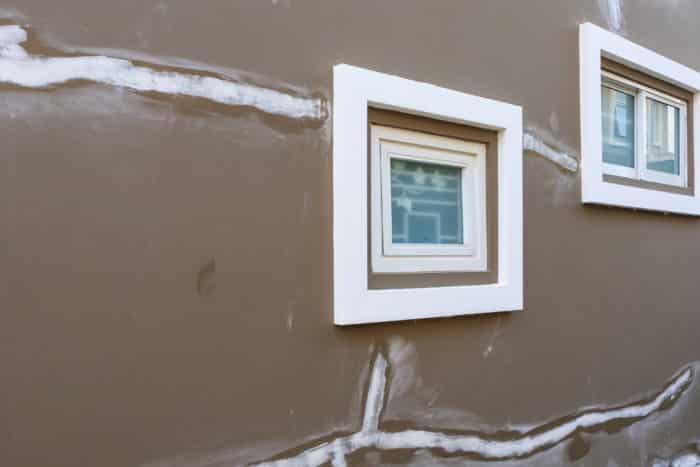
Stucco cracks at window and door corners, whether diagonal, horizontal or vertical, may allow moisture into a wall and possibly be an indication that there are structural problems. Structural engineers usually examine these cracks equally part of their overall evaluation of a home. Much of the time these cracks are not major, simply more of a maintenance issue involving sealing, patching, or caulking. Which if not done, over fourth dimension may cause extensive damage to a wall and perhaps mold problems.
Homeowners should know to identify which cracks are serious or a structural issue.
Stress – 1 of the chief reasons for cracks
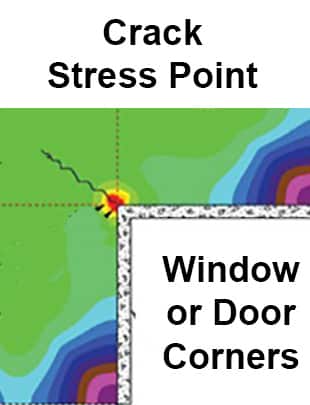
One of the about common causes of cracks at window and door corners is stress. When a home is starting time stuccoed during the construction process the stucco goes through a curing process as the stucco hardens. This occurs basically three times in a Traditional hard coat application. It occurs in the application of the:
- Scratch coat
- Brown coat
- Finish glaze
If ane or more of these three coats does non cure properly, then the stucco will be a piffling weaker and in that location will exist more shrinkage cracking. There will exist both microscopic and hairline cracks. Yet, the swell is by and large not evenly dispersed over the unabridged wall and at that place is a trend for more stress to be concentrated at the corner areas of doors and windows. Thus, in that location is more of a tendency to scissure at the corner areas due to the stress.
Re-entrant cracks
These corner cracks are often referred to as re-entrant cracks. This same process is not unusual in concrete besides. Both concrete and stucco accept several things in common: Portland cement, water and sand, so it not inconceivable that they both suffer from shrinkage cracking. The good news is that the majority of the time, shrinkage cracks do not leak. They are a natural process and normally a maintenance result at most.
The size of the window, door or other opening in a stucco wall
If a window is a small-scale 12 inch by 12 inch window, all other things being equal, information technology will not feel as much shrinkage cracking as ane that is 6 feet past 4 anxiety in size. As well, a door three foot wide will not have equally much or as server keen, as a glass sliding door x foot woot wide. The larger a door or window opening, the higher the probable hood that at that place will be a higher level of stress.
Window cracks running to other wall penetrations
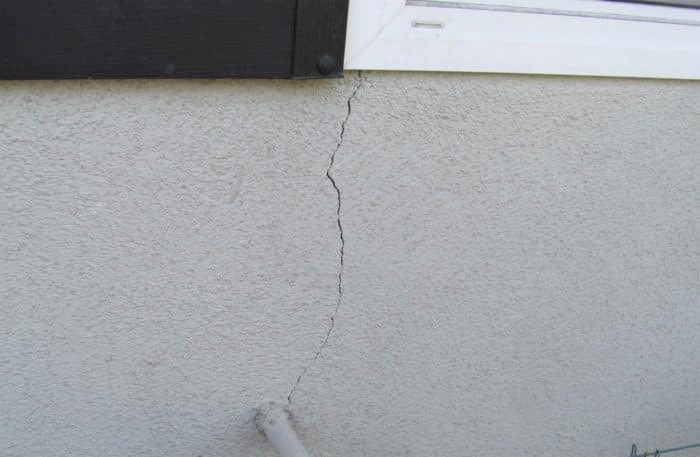
It is not uncommon for a crack from a window corner to run to another penetration nearby. It might exist to some other window, door, vent, or to a pipe going through the wall. Basically, the crack is a form of stress relief for the stucco.
It may be occurring for many reasons, including lathing issues, workmanship or that the stucco may lack sufficient cement in it. Thus, the stucco is weak and will fissure easily. If at that place are a lot of these types of cracks going to other penetrations, information technology may be wise to consult with a professional stucco contractor or engineer and mayhap have the stucco tested for strength, if they do not have a satisfactory explanation for the cause.
Note. Not all cracking is due to shrinkage and non all cracks in window and door areas are at the corners. Shrinkage cracks are considered an internal cause of cracking. There is also, other internal causes and there are cracks that are caused past external issues.
No control joints or improperly installed or placed
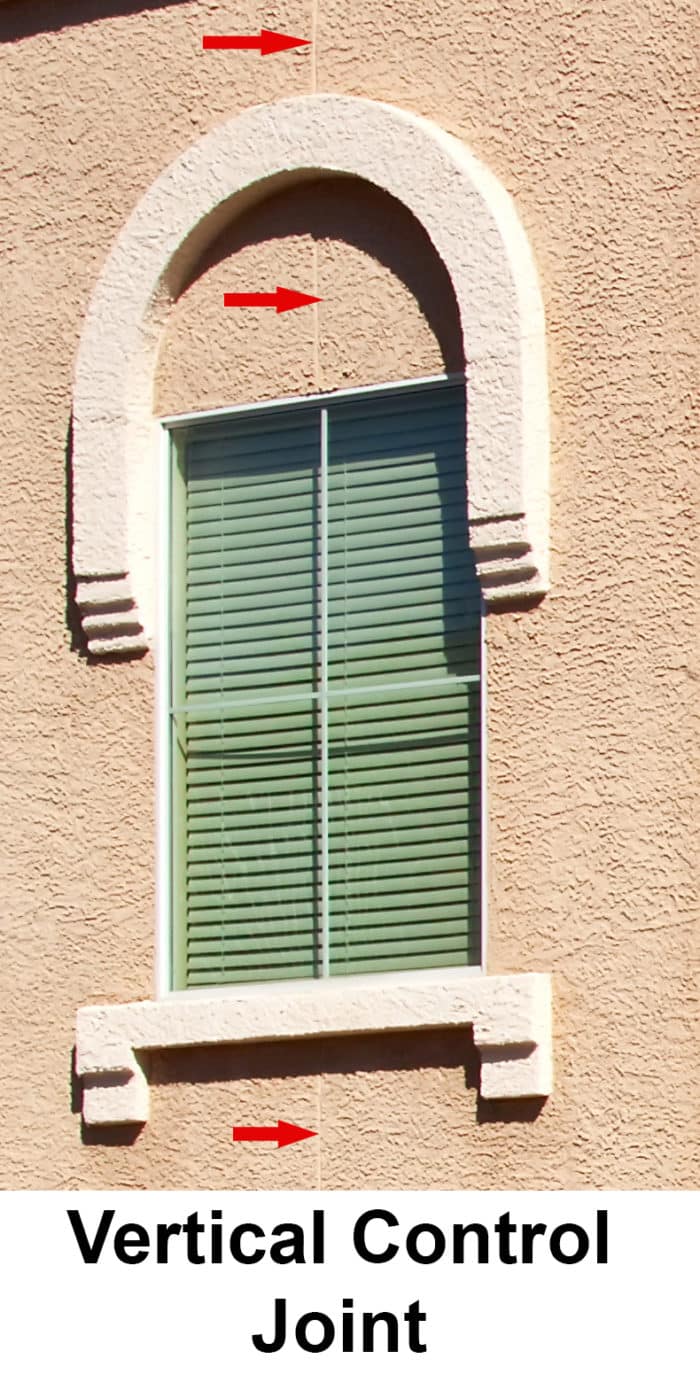
To allow for some motion of a stucco wall, including movement due to expansion and contraction, as well as stress, stucco contractors will often identify control joints in a wall. Yous could say that they dissever the wall into sections. The purpose of the command joints is to let for express movement with minor or no keen. Having properly installed control joints will as well help reduce cracking at window and door corners.
In that location are diverse types of these joints, and a variety of companies industry them. The type and the location of the control joints are often specified past an engineer, the builder or past the manufacture or designer, if a proprietary or an EFIS system is used.
There are sever types of joints; nearly are either a one-piece joint ("M" shape or "V" shape). Another type of a 1-piece joint that is often used at doors and windows is a "J" control joint. A third type of control articulation is a "ii-piece" joint the often has a membrane behind it to prevent moisture from passing through the joint. This type of joint may allow more expansion and contraction than the one-piece joints, i.e. ¼ to ½ of an inch.
Controls joints are by and large required by the Building Code for Traditional hard glaze stucco applications.
Building Code
The majority of Building Jurisdictions have the following basic requirements for Traditional difficult glaze applications.
- Joint spacing should not be greater than eighteen feet in whatsoever direction.
- No console area should be greater than 144 sq. ft. on vertical applications.
- No console should exceed 100 sq. ft. over horizontal, curved or angular sections.
- The length-to-width ratio should not exceed 2 ½ to ane in any given panel or department.
"J" command joints are often used around window and door frames and are manufactured with expanded flanges and so that a crack is less likely to occur or exist exposed. The pattern of "J" joints locks the stucco to the edge of the joints and reduces separation at the joint's edge.
Note, that control joints are non ever located in the center of a window as shown in the photograph. The photo is just ane example.
Tensile strength of stucco
Stucco and physical have a number of similarities. They both accept cement, sand, and h2o as part of their mix. They both have splendid compressive strength: ie most concrete may accept a compressive strength of 2,500 psi to 4,000 psi and stucco often has a compressive strength of 2,000 psi to 3,000 psi.
However, traditional concrete may have a tensile strength of 300 to 700 psi. but stucco may have merely a 100 to 200 psi tensile forcefulness, much less than physical. If you add rebar to concrete, and then tensile strength goes up exponentially.
Basically, due to the weak tensile forcefulness of stucco when compared to some materials, it may be more decumbent to cracking when there is movement of a wall, foundation or if there is expansion and contraction due to significant thermal changes.
Dissimilar materials against each other may cause cracking
1 of the mutual areas to find cracks in stucco is where there is a transition from stucco to some other blazon of material or cladding. Many homes will have ii, sometimes three or more types of claddings for architectural purposes. Possibly a mix of stucco, stone, vinyl, woods, or some other type of cladding. At these transition points it is non uncommon to discover stucco swell. Mostly due to dissimilar materials having different expansion and contraction coefficients, or lack of proper flashing. The same concept applies to windows and doors and the stucco around them.
Check around the perimeter of your window and doors for cracks and gaps
Window and door frames are not stucco, they are usually wood, metallic, vinyl or a PVC blazon of cloth. Thus, the frame materials aggrandize and contract differently and react differently to rain and temperature changes than stucco. This creates stress and gaps that may result in cracks, leaks, or both.
Look carefully. Check to come across if the stucco goes right up confronting the forest, metallic or vinyl frame of the window or door or if in that location is a gap of approximately 1/eight to ¼ of an inch, plus or minus a little. If there is a small gap, and it appears sealed or caulked, that is usually a good sign and nigh likely there is probably a slice of bakery rod behind the sealant or caulking. This will help forestall wet intrusion and reduce or foreclose cracks; for information technology allows for limited move without cracking the stucco. If there is none, it is ofttimes considered an issue past forensic inspectors. Contractors can salve a picayune time and a few dollars by non taking this actress step, but in the long booty, it may plow out to be a costly problem for the homeowner. Note, that the building code may not require this configuration of materials, but the building lawmaking is just a minimum set of requirements, not necessarily the all-time mode of doing something.
Manufactured foam trim or moulding around windows and doors – they may have very thin cracks
Architects and home builders volition oft install pieces of cream trim or moulding effectually windows and doors to accent the doors or windows. The cream trim looks just like the rest of the stucco on the building but may be a dissimilar colour or texture to highlight the windows or doors. This trim is usually secured in place by a construction grade exterior adhesive. If the trim is not installed properly, thin hairline cracks may appear where pieces are fitted together or secured to the stucco. These cracks are usually a maintenance detail and occasionally may allow wet intrusion. Should any cracks exceed 3/16 or 1/8 of an inch, then it is more of a business organisation and further investigation as to the cause is suggested.
Leaks at windows are not always due to stucco issues
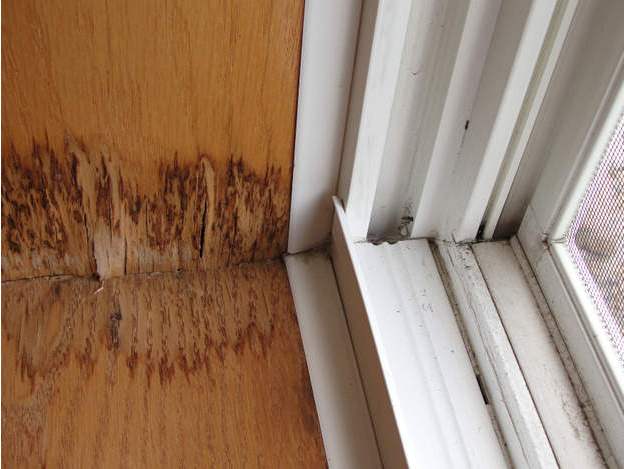
Leaks around windows are non ever due to defective stucco, poor application or cracking of the stucco, but due to issues with the windows or frames themselves. Window frames will occasional get damaged when existence transported to the job site past shippers who are not ever gentle in treatment the windows or the packaging that the windows were wrapped in during transportation may accept been improper or bereft. Boosted, windows are unremarkably not thoroughly inspected before beingness installed and even if they are damage, some workers will yet go-a-head and install the window.
Installed improperly. Inspectors will tell you that from time to time, they will find a window, or even a group of windows installed upside down because the laborer did understand how to properly install the window. When this happens, well-nigh windows will leak because the drainage design of the window will fail.
Another problem is that the fabric used to seal sliding and other types of windows and some doors may be worn out or damaged. These materials are intended to keep water, insects, or current of air from seeping or blowing through. They are frequently tubular gaskets, cream tape, fuzzy types of materials, etc. Check these equally well.
Homeowners should also bank check a leaking window to run across if the frame or any of the joints are damaged or pulled autonomously at a corner or in some other area of the window. As well, look for cracked welds in both metal and vinyl windows, and if you lot find any, the articles warranty may encompass the problem.
Windows that were non properly flashed
If certain types of building paper or wraps were used and they were exposed too long to UV rays or a destructive environs, then the materials will often degrade over time. Should a firm sit for extended periods of time with these types of flashing materials exposed, then they may fail.
At times the flashing, regardless of the type volition become damaged in the structure procedure itself, and occasionally the window may never get flashed. Failure to properly install and flash a window is one of the principal reasons for window leaks.
Alarm signs that a window may have a leak
Efflorescence, bubbles, peeling, flaking, blisters and mold
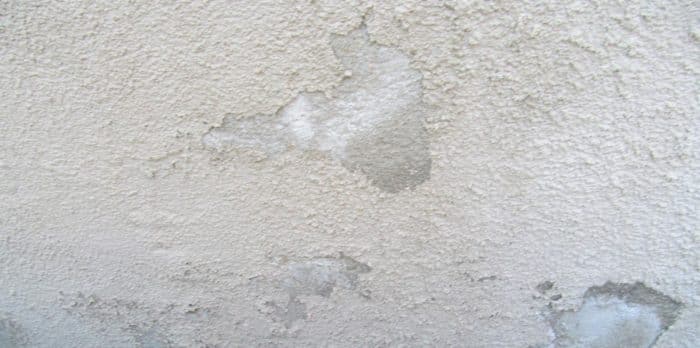
Water leakage is a common issue with stucco in areas where seasonal rain is the norm. If water gets behind stucco it volition soften the areas that information technology comes in contact with, eventually causing the stucco to flake, peel, chimera or break abroad and fall off, at times in sheets.
Efflorescence.
When there is moisture in a stucco wall, at times it will saturate the stucco from the dorsum side due to a leak in the window area. Since stucco is a porous material, information technology may migrate to the exterior side through a capillary type of process and and then the sun and wind on the wall will cause the wet to evaporate, leaving a white salt crystal substance on the walls' exterior wall called efflorescence.
Finish coat of stucco flaking off
If the top layer or finish glaze of a stucco wall is peeling off or flaking, it may be due to moisture behind it which causes it to carve up from the residuum of the wall. Basically, it loses its bonding ability.
Bubbling under the stucco finish glaze or paint
If there are bubbling under the top layer of the stucco or paint, it may be caused by water being trapped in small pockets or voids. At times if you push on these bubbles or blisters, they will rupture, and water may even drain out.
Damp looking stucco
Should a department of stucco located close to a window or in the vicinity under a window be slower to dry out than the balance of the stucco on the dwelling house, then there is a gamble that it's because the window or cracks around the window has immune wet to enter into the wall behind the stucco.
Mold on the stucco near or under a window
If there is a dark like discoloration on the stucco, it may exist from mold or some other source. At times, information technology develops from moisture getting into the stucco from the exterior side and at other times, from wet on the behind of the stucco.
Depending on the amount and severity of the higher up issues; maintenance, repair and sealing of cracks around the windows or doors is oftentimes necessary. Should the cause be due to other issues, then repair of them is wise too, for moisture in a wall can cause woods rot, structural damage, equally well every bit mold.
Structural concerns involving cracks at window and door corners
Evaluating if cracks at window and door areas relate to structural problems is a two step procedure.
Footstep 1. Showtime examine the cracks at whatever door and window areas or corners.
Pace 2. Examine the balance of the house for "Crimson or Yellowish" flags that there is or may exist a structural problem with the house as whole, just not at the windows or doors.
Determining the seriousness depends on various factors: including
- The number of cracks effectually doors and windows
- Location of the cracks; at corners or parallel with the frame, or perpendicular to the frame
- Size of the cracks. 1/eight inch or larger
- The cause of the cracks
Structural engineers
They volition not only wait at the cracks at the doors and windows, but they will besides examine the entire house. Non just will they arroyo their examination from a site-specific viewpoint, merely they will also accept a global view to the overall problem: pregnant that they will look at the entire neighborhood and surrounding expanse as office of their investigation.
Rather than being merely site specific they will determine if there are broad geotechnical issues or problems in the area. They will evaluate the types of soils in the area and if there has been any soil motion or landslide concerns. They may check local geological maps and do a visual cheque to encounter if nearby streets, curbs and gutters are wavey or slightly starting time, indicating the soil is shifting or moving. They may even enquiry if there are any undercover tunnels, subways or old mines that may cause subsidence or other bug.
On site they will examine the types of soils the home sits upon and if at that place are expansive soils or evidence of slope creep or settlement. All of these types of things can cause the foundation to shift or fissure, which so may cause the stucco to scissure, including around the doors and windows.
Factors indicating a crack may be more serious or structurally related
1/8 inch or wider. Cracks over 1/viii inch wide or wider are frequently an indication that there may be a structural consequence involved.
Over three ft long. There is no specific length that contractors or engineers feel is an indication of structural issues, only some feel that one's over three feet in length may deserve more than consideration.
Cracks that extend to the corner of the building. Cracks that run from a window to the corner of a building may be given actress weight in analyzing the cracks. At times there may be a crack in the foundation most the corner; perhaps the foundation corner has dropped or settled.
Cracks running though the foundation and extending to window or door corners. Should a scissure run from a window or door corner and continue through the foundation or basement wall, then information technology would fall into a significant structural business concern category. These types of cracks should exist reviewed past a structural engineer.
Structural problems dealing with soil and foundation problems oftentimes crusade cracks in stucco
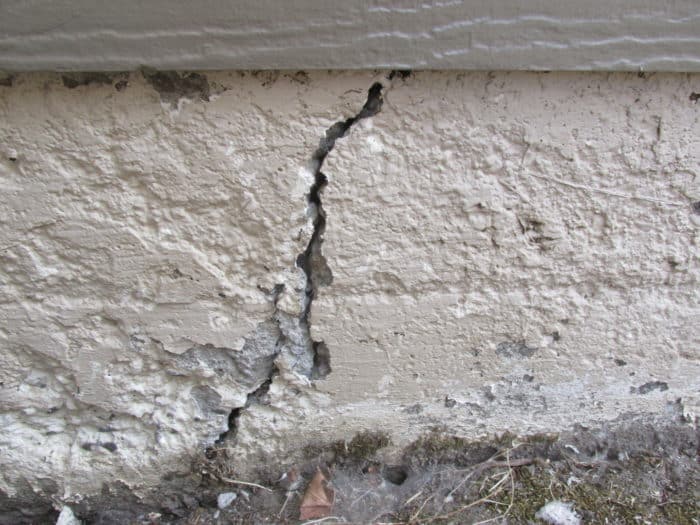
Stucco is not a flexible type of cladding for a home. Information technology is rigid and considered to exist more than breakable in nature than a wood or vinyl cladding. Thus, more susceptible to cracking when it experiences stress forces from soil or foundation movement. Soil motion alone tin cause concrete foundations to crack and or fail. Once the foundation shifts or moves, so the framing that is attached to it will likewise motion.
All of these forces can hands event in cracks at door and window corners. Too, if forest framing members get exposed to wet form stucco leaks or other sources. They may deteriorate or lose structural forcefulness from wood rot and one time this happens the framing supporting the stucco may motion or fail.
Homeowners should not rule out that structural issues are causing the cracks and therefore, should wait for other alert signs around the home of structural problems.
Other warning signs that a domicile may take structural issues include:
- Cracks in the drywall
- Doors or windows not opening or closing properly
- Sloping or sagging floors
- Roof wavy, sagging or bowed
Learn other warning signs of structural issues.
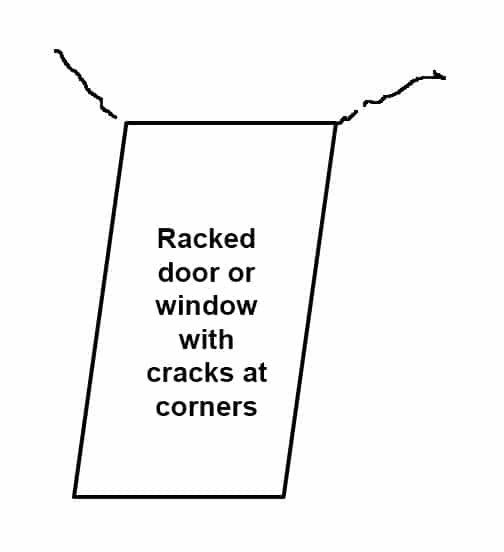
Racking – a serious alert sign
If doors and windows are racked and there are cracks at the corners or sides, and so there is a serious structural business organization.
Racking is when the sides of the doors or windows are not at a xc-degree correct angle to the top and lesser. For racking to occur, there full general has been tremendous forces that acquired it. Examples would exist a tornado, hurricane, convulsion, landslide, or pregnant slope creep. If severe plenty homes may even collapse.
If racking has occurred, there may well be cracks and gaps at the edges of windows and doors that will allow water to seep into.

- Behave a yearly inspection of all outside doors and windows, likewise as, all of the stucco cladding on the domicile.
- Check the interior window and door areas for show of moisture, stains or mold.
- Seal or repair all cracks at window and door corners.
- If at that place are cream trim pieces around doors or windows, look for cracks in that location likewise.
- Examine where any stucco abuts window and door frames for gaps or cracks. Seal as necessary.
- Look at the actual window frame itself, whether metallic, vinyl or wood for damage or cracks.
- Be sure that all weep holes in window and door frames are clear of droppings and that they are not chock-full.
- If there are significant or concerning cracks, racking, or there is an indication of structural bug, and so consulting with a qualified stucco professional person or structural engineer is wise.
- If the cracks appear to be a maintenance type affair, then repair or caulk as needed. Many contractors volition use an outside silicone caulking because information technology is very flexible, fifty-fifty after it has cured, so it makes a expert sealant in many types of applications.
Bottom Line
Stucco cracks at window and door areas and corners are very common and generally are not a structural business organisation. However, if moisture is penetrating through the cracks, there is a take a chance of structural harm, wood rot and mold.
In some of our articles we provide links to products that may be beneficial given the subject affair of the content. Nosotros receive a small committee if yous choose to purchase a product or service after following one of our affiliate links but the price is the same for you.
Source: https://buyersask.com/exterior/stucco/stucco-cracks-at-door-and-window-corners-which-ones-are-serious/

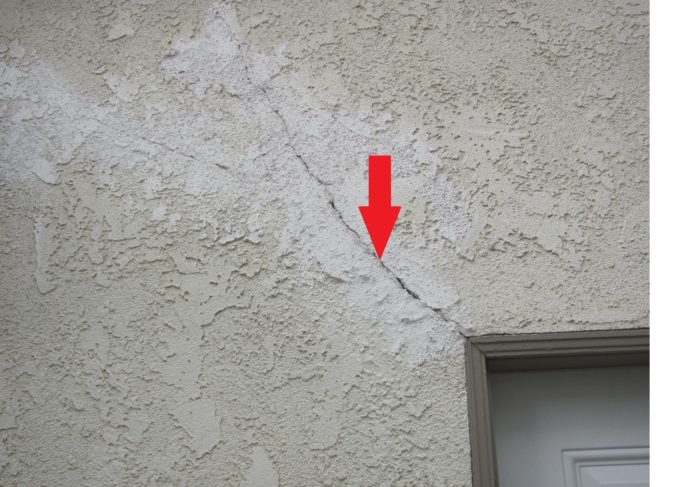
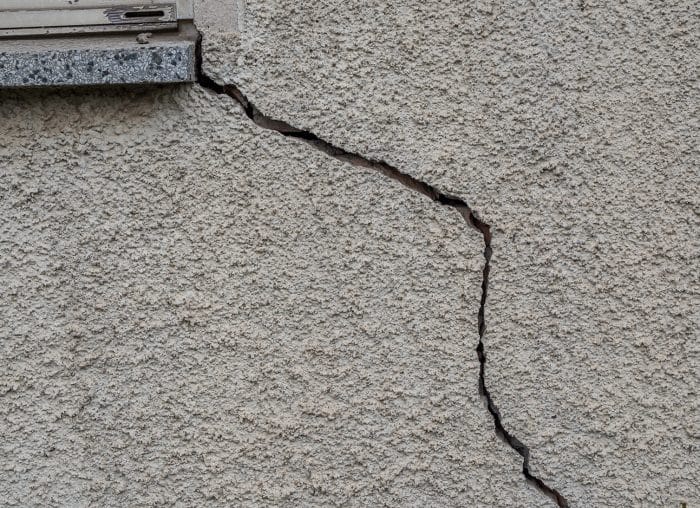
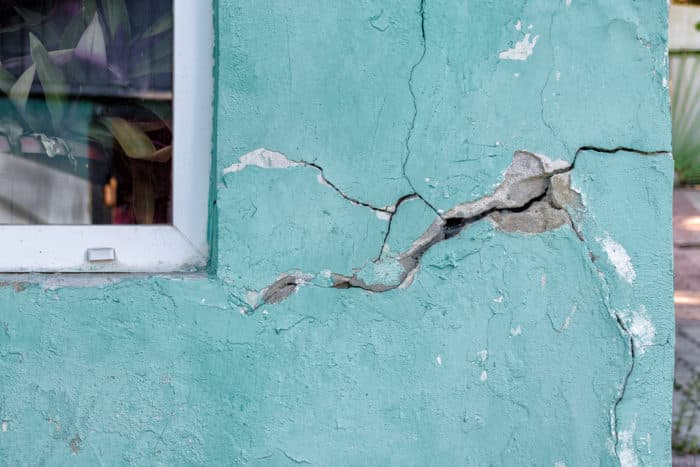
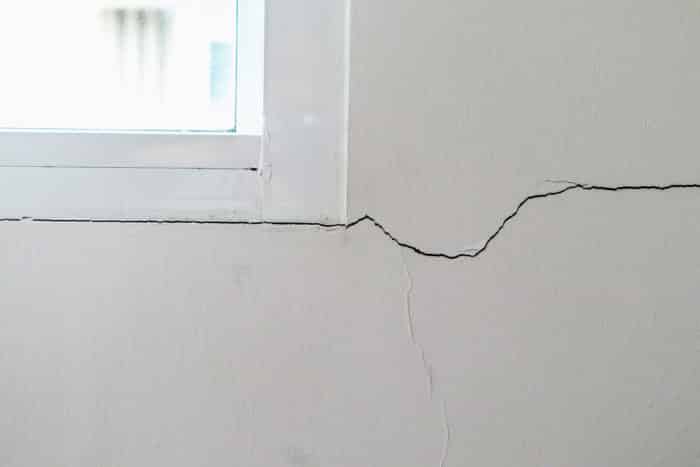
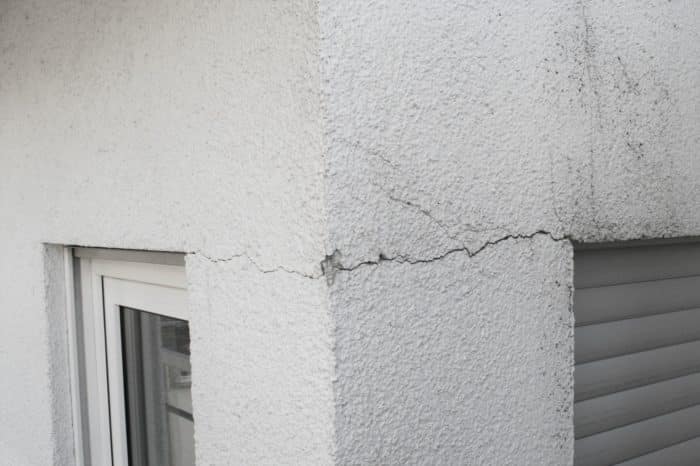

0 Response to "How To Repair Stucco Cracks Around Windows"
Post a Comment